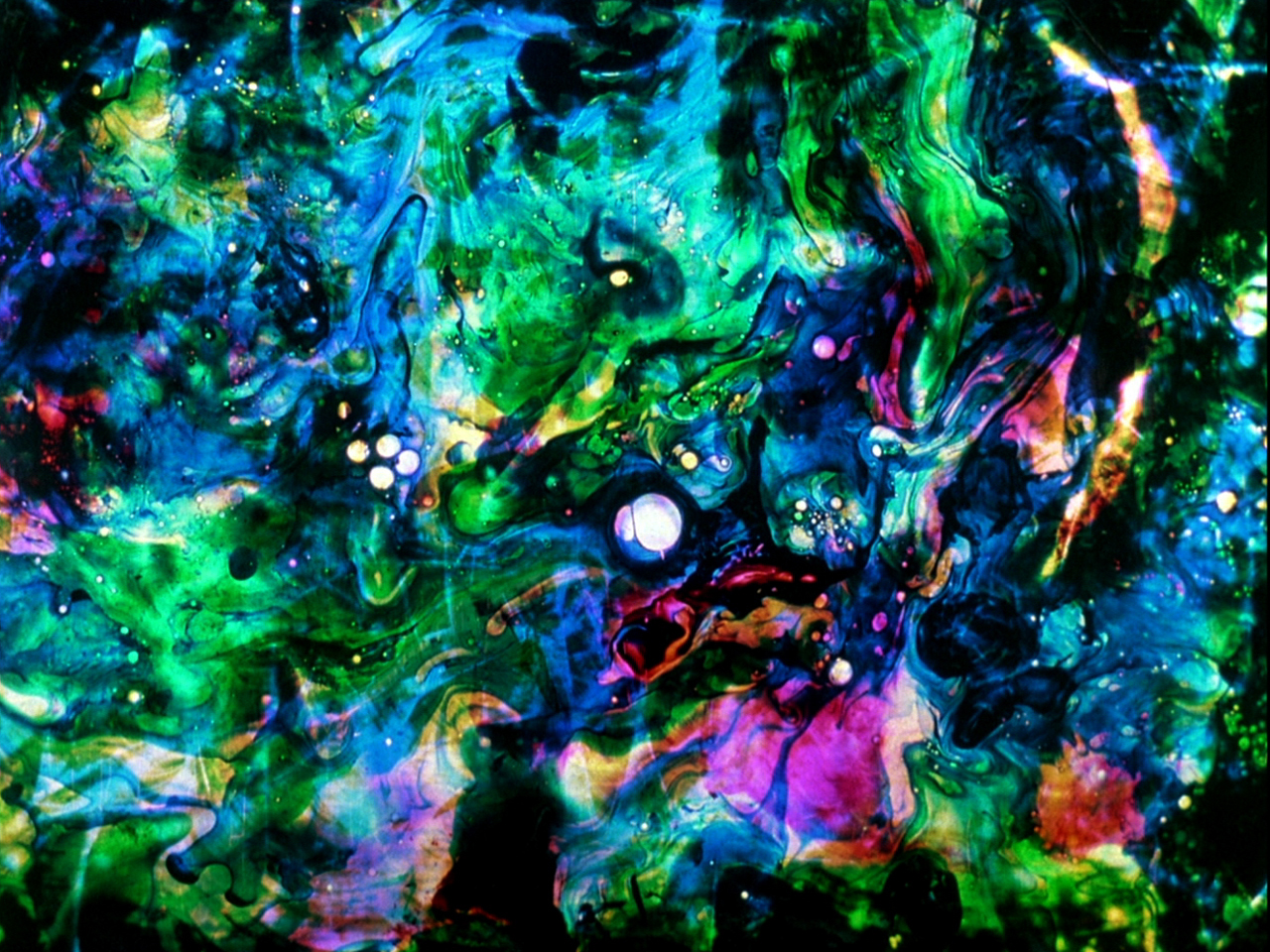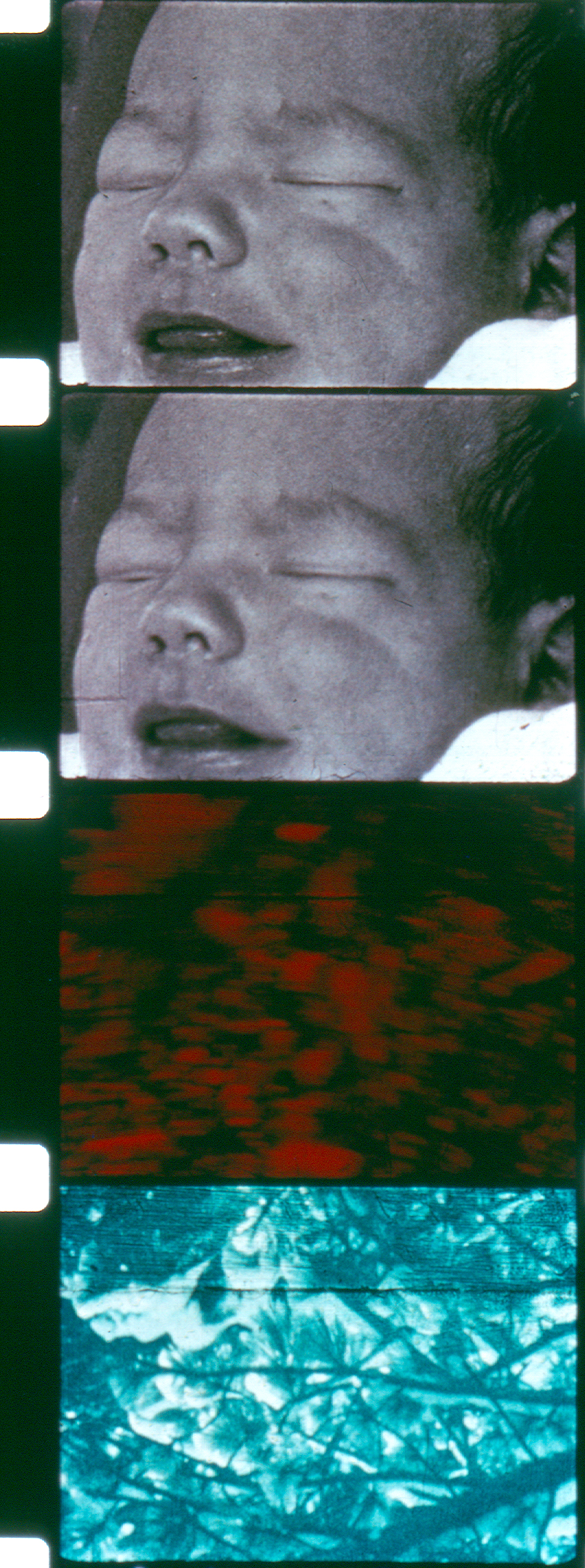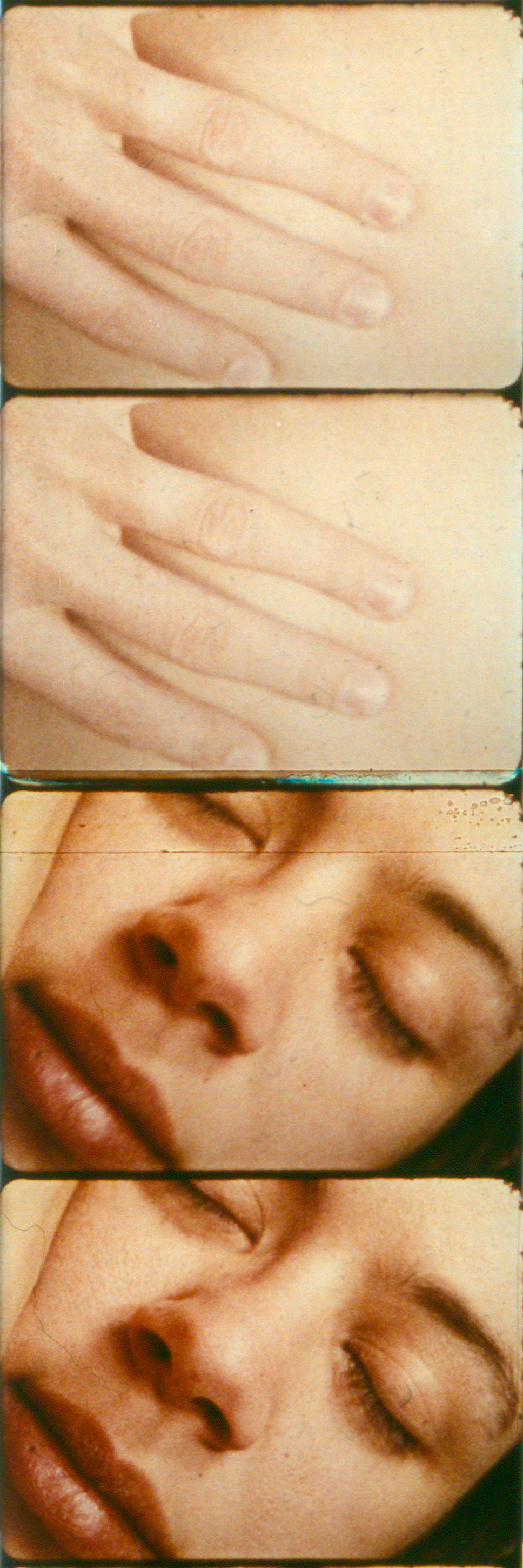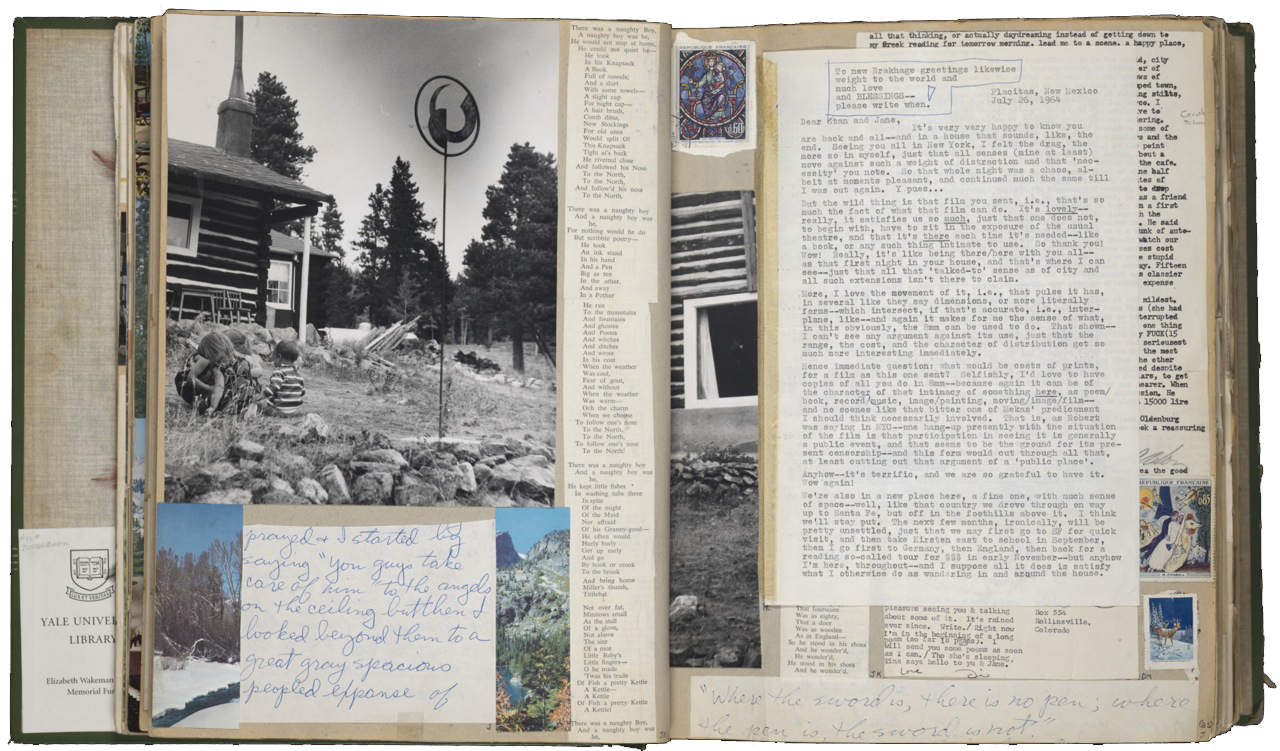To describe the thinking behind his films, Stan Brakhage often quoted a saying attributed to the ninth-century Irish theologian John Scotus Erigena: “All things that are, are light.” He got the line from Ezra Pound, and his attachment to it was one of the few constant principles connecting the hundreds of experimental films he made between 1952 and 2003. Brakhage’s movies could last anywhere from eight seconds (1967’s Eye Myth) to more than four hours (1965’s The Art of Vision, a longer version of his early Dog Star Man); they could be intimate records of his family life or abstractions made by painting, scratching, or collaging directly onto the film stock itself.
What his films shared was an obsession with light—the patterns it makes, its effects on the eye and the brain, how different shooting methods and editing strategies could make it behave. Many of Brakhage’s movies skip from shot to shot so quickly that it can be almost impossible to keep track of what they show. Each image lasts just long enough to register as a pattern of light and color before another hits the eye in its place. “Most people,” Brakhage said in a 1974 interview—one of nine revealing exchanges from across his life newly collected by the scholar Suranjan Ganguly in Stan Brakhage: Interviews—“are caught in tricks imposed by some very greedy people, so they move along certain channels of prescribed light. And the way they get tricked is that they don’t look at the qualities and varieties of light. They’re only trained to use it as something bouncing off objects, or papers, or signs; finally even the objects cease to exist.”
His mission, which he pursued with a zealous intensity, was to liberate the eye from such “prescribed” ways of seeing. The insect wings, twigs, and fragments of flowers and leaves that he applied directly to strips of 16mm film in Mothlight (1963) and 35mm in The Garden of Earthly Delights (1981); the streaks and globs of paint that seem to shine with an inner illumination in films like The Dante Quartet (1987); the arcs of light that bend around the underwater surfaces of Boulder Creek in Commingled Containers (1996): Brakhage’s films train you to look at the world as if it were—as he wrote in the first paragraph of his 1963 book Metaphors on Vision—“alive with incomprehensible objects and shimmering with an endless variety of movement.”
By the mid-Eighties, when he’d settled in Boulder, Colorado to live, work, and teach, Brakhage was increasingly dispensing with the camera in favor of glorious hand-painted displays he applied to the film frame-by-frame. (In these cases, figurative footage occasionally still appeared in odd and unexpected settings—one section of The Dante Quartet was painted over what Brakhage identified as “a worn-out 70mm print of Irma la Douce.”) From then until his death in 2003 he was one of his country’s most revered experimental filmmakers. That the manipulation and processing by hand of 16mm film is still a dominant practice in American avant-garde cinema—from the otherwise disparate work of filmmakers like Phil Solomon, David Gatten, and Mary Helena Clark to the output of the Brooklyn-based collective Mono No Aware—has much to do with the enduring influence of Brakhage’s approach to dissecting light onscreen.
As his reputation and influence grew, Brakhage kept working at a compulsive pace. (In the Fifties and Sixties, to support his family, he had expanded his prodigious output still further to include TV spots for an electrical company, industrial shorts, and state-sponsored films like Pittsburgh and Colorado Legend.) He made his last movies, the calligraphic Chinese Series (2003), from his sickbed, scoring the film strips with his fingernails and softening them with spit. Watching Brakhage’s films, you feel something close to awe at the range of textures and depths of excitement he found in the most commonplace situations. The transporting sixty-seven-minute Text of Light (1974) came entirely from footage of the refraction of the sun’s beams in an ashtray.
This is not a sensibility that would seem to lend itself to making home movies, and there is a disquieting tension in many of the films Brakhage made about his family during his first marriage. He had a powerful impulse—one that extended less often to people outside his home—to film his wife Jane and their five children. He more than once filmed Jane giving birth, turned their arguments and lovemaking into cinematic subjects, embellished his footage of their life in rural Colorado with wild superimposed images drawn from Norse mythology, and—in the Eighties—made pained films about their separation and divorce. But the moment he turned his camera on his family they, too, became concentrations of light whose “qualities and varieties” he could study. The films he made of them shine with love and tenderness and at the same time suggest an odd disregard for the recipients of that love.
Advertisement
Brakhage and Mary Jane Collom married in 1957, when he was twenty-four and she twenty-one. (He was born in 1933 in a Kansas City orphanage from which he was removed by a childless couple, then brought to Denver with his adoptive mother at age seven after his parents separated.) They divorced thirty years later. He soon remarried and several years afterward, in an interview from the early Nineties, admitted that his second wife, Marilyn Jull, had taught him to sense “some falsification in [the] process” of taking moving pictures of one’s family. At her request, he never made films of Marilyn or their children. After her divorce from Brakhage, Jane changed her surname to “Wodening”—“the female version of the god Woden,” her ex-husband explained in the same interview, which “shows a predisposition to the goddess aspect of daily living.” For the next ten years she lived as a hermit in what on her website she says was “a tiny cabin with no amenities at ten thousand feet altitude.” She would use that experience more than a decade later as the basis for a book called Living Up There—an installment in the large body of memoirs, fable-like story collections, and collections of nature writing she’s produced in the twenty years since she left the mountains for Denver.
In 2015 she published Brakhage’s Childhood, a first-person account of the first twelve years of the filmmaker’s life based on interview sessions she held with Brakhage between 1983 and 1985, in the grim final years of their marriage. It is a dark and fascinating book. In this long litany of childhood grievances and confessions—the stepfathers who bullied, beat, and ignored him; the months he spent relocating with his mother from motel to motel; the thefts he committed and fires he set; the many guardians and homes through which he passed; his weight fluctuations and chronic health problems, including asthma, allergies, and a hernia; the movies and comics in which he found flashes of relief—you can see Brakhage giving himself a kind of antiheroic backstory, pleading as if in court for Jane to absolve him for “losing,” as she has him say here, “all the basic securities that might have opened me to the needs of others.”
Brakhage was a profuse analyst of his own behavior. The conversations in Stan Brakhage: Interviews show him moving erratically between intricate self-justifications and pained recriminations over the course his marriage took. “I think Jane was very much more a private person than she was permitted to be,” Brakhage reflected ruefully after the divorce, “not only vis-à-vis within the family, but with respect to the rest of the world.” The disruption of her privacy became the material for some of his most unsettling and difficult films. In 1958, during a heated argument, Brakhage and Jane started angrily passing a running camera back and forth between them and taking turns waving around an electric light. The quarrel became a kind of spontaneous artistic collaboration, and the source for much of the footage in the film Brakhage proceeded to title Wedlock House: An Intercourse (1959).
Shortly after that episode, Brakhage took Jane to visit two of their friends, the composer James Tenney and the artist Carolee Schneemann, for what he later called “two very disturbing weeks.” Two years earlier, he had used a filmed sexual encounter between Tenney and Schneemann as the basis for his film Loving (1957). (In 1965, Schneemann—a great painter, filmmaker, and performer of their generation—answered Brakhage’s film with one of her own, Fuses, an exultant vision of herself and Tenney making love under the watchful eye of their cat.) Now it emerged that Brakhage, as he later put it, “felt an urgency to take Jane into a relationship with them.” This did not go over well: “Jane, not sharing my mythos of marriage, and certainly not by way of another man and woman, resisted all of that concept tremendously.”
The film that emerged from that visit, Cat’s Cradle (1959), is a display of the level Brakhage’s powers as an arranger of images had reached by the late Fifties—a rapid, thrilling montage of domestic images in which the two couples are brought, by the magic of Brakhage’s editing, into precisely the kind of interwoven harmony onscreen that Jane had turned down in life. It hardly hints at the turmoil out of which it came.
Advertisement
Wedlock House and Cat’s Cradle are part of a trio of family portraits Brakhage made in 1959. The third, Window Water Baby Moving, came out of an episode that further tested the limits of Jane’s preparedness. She was pregnant with their first child and wanted Stan to oversee the birth. To keep himself from fainting, he insisted on bringing his camera. Forty years later, he remembered with startling frankness the conversation that followed:
I wanted to take some images of Jane in the bathtub showing the pregnancy before the actual birth, and she got very, very shy—understandably. She had never been approached this way before in her life, and very few people have. And in her shyness she said, “Oh, I can’t do this.” So I said, “Okay, okay,” and I tore the film out of the camera and spread it all over the floor and made a big dramatic scene and said “All right, let’s forget it!” And then a half hour later she bravely relented. She had pulled her courage together and said, “Okay, we’ll do this.”
He got his footage: the resulting film is a kind of call-and-response between images of the birth itself and earlier glimpses of Jane, pregnant, half-submerged in bathwater. It is striking that the material over which Brakhage made such a scene had no bearing on the birth itself; he needed to “take some images of Jane in the bathtub” not to steady his nerves during the delivery but for the sake of the movie he’d formed in his mind. One can’t help but marvel that, even here, he’s thinking in such terms, worrying over the structural integrity of the film his life has furnished an occasion to make.
The last minute of Window Water Baby Moving contains a series of extraordinary shots of Brakhage beaming at his newborn daughter with a kind of deranged joy. Taken by Jane moments after she’d given birth, they have an electric effect on the movie as a whole. Like the footage Jane shot in Wedlock House, they suggest that Brakhage’s unstinting use of his and Jane’s personal life for filmic material could make openings for the couple to collaborate as something like creative partners. Similar openings appear throughout Dog Star Man, a dazzling feature for which Brakhage used increasingly colorful and multilayered superimpositions to intersperse Jane’s footage of himself climbing a snow-covered hill with his images of her and their infant daughter. Jane became his interlocutor as he planned each of his films and a co-editor as he pieced them together.
But neither she nor her children wanted the level of attention from Brakhage’s camera they got. The trajectory of Brakhage’s career suggests that he grasped this problem too late to undo its effects. By the time he made Tortured Dust (1984), his last portrait of the family he raised with Jane, his children had all left home; the footage in that film of them as teenagers was compiled and edited in retrospect. It is a dark and stately movie in which domestic rhythms develop largely without the mythic flourishes or sublime montages that defined Brakhage’s earlier depictions of his family life. Writing about the film’s view of Jane and the Brakhage children, what J. Hoberman singled out was “the studied impassivity on their faces.”
Tortured Dust was one of Brakhage’s last works of autobiography; by the start of the Nineties, he had moved largely to either cameraless and hand-painted films or ones centered on landscapes and the natural world. In the last interview he gave, Brakhage remembered that when Marilyn forbade him to photograph her he felt “as if I was relieved of an enormous burden and one that was almost hopeless to begin with anyway.” Those are bitter words: they make the scrutiny Jane underwent seem somehow gratuitous, a “burden” on the very person who had required it. But Brakhage’s increased use of abstraction (a word he hated) did seem to free him, giving him the power to concentrate exclusively on the subject to which all of his films at one point or another reverted: the drama of seeing, in which any burst of color could be an unexpected epiphany or any shift in the visible texture of the film strip a shock. It let him delight in the movement of light “straight out from the inside of the mind through the optic nerves,” as he had put it in the Sixties, without troubling over his responsibility toward the people onto whom that light attached.
There is a startling rupture midway through the second interview Ganguly collects—a three-way conversation between Brakhage, Jane, and the filmmaker Hollis Frampton from 1973. Stan frets over having never made a real “portrait of Jane.” When Frampton asks her to speculate why, she answers that “he just uses me.” The interview instantly becomes the stage for an argument between the spouses. At stake is the question of whether Brakhage has the power to differentiate Jane as a person in his art—to treat her as more than “part of a pretext for [a] self-portrait”—and whether the imbalance between them has “ever been otherwise for an artist” who draws on his marriage for his work. “I’m fascinated right now,” Brakhage tells Frampton slightly later in their exchange,
to make a film bouncing the light off Jane, which is something I have never really done, and to make it a film that’s totally about her, in the sense that all its considerations center on her. And that I’ve never done.
“Do you like to have light bouncing off you, Jane?” Frampton asks her. “I’m trying, I’m trying,” she says.
Stan Brakhage: Interviews, edited by Suranjan Ganguly, has just been published by University of Mississippi Press.







